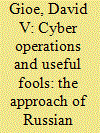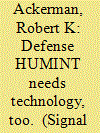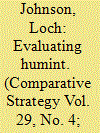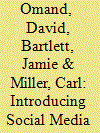|
|
|
Sort Order |
|
|
|
Items / Page
|
|
|
|
|
|
|
| Srl | Item |
| 1 |
ID:
156561


|
|
|
|
|
| Summary/Abstract |
The building of reliable covers has always been of the utmost importance for clandestine Humint. Using both primary and secondary sources, this study seeks to examine how classical authors and modern scholars have dealt with this topic, and which kind of covers have been the most used throughout history in different sociopolitical contexts, and what are the new perspectives for today’s challenges. Findings suggest that a careful reading of the political milieu in which intelligence officers are required to work, and a certain degree of creativity, are the essential premises for the construction of a plausible cover; that some apparently outdated disguises such as merchants, itinerant monks and philosophers should be understood more broadly today to include business people, humanitarian NGOs and academics; that undercover practices have been theoretically and historically recognized as necessary and convenient by a great number of societies, often with scant regard for ethical considerations.
|
|
|
|
|
|
|
|
|
|
|
|
|
|
|
|
| 2 |
ID:
097038


|
|
|
| 3 |
ID:
161529


|
|
|
|
|
| Summary/Abstract |
This article argues that Russian intelligence has achieved recent success in influencing democratic elections and referenda by combining the traditional Human Intelligence (HUMINT) discipline of manipulating useful fools with cutting edge cyber tactics, including hacking, phishing, social engineering, and weaponizing purloined information. This essay further argues that this synthesis yields greater effects than the sum of its parts. Given its potency, democracies and NATO members should expect to confront this type of threat more often. The 2016 American presidential election is used as a case study to conceptualize Russian hybrid intelligence, a new term reminiscent of Soviet ‘complex active measures’ and updated for the twenty-first century.
|
|
|
|
|
|
|
|
|
|
|
|
|
|
|
|
| 4 |
ID:
074143


|
|
|
| 5 |
ID:
099709


|
|
|
| 6 |
ID:
139513


|
|
|
|
|
| Summary/Abstract |
Over the past six years, certain crowdsourcing efforts have begun to resemble, and perhaps augment, national security intelligence collection. As with any budding field, purveyors of intelligence crowdsourcing have been somewhat inconsistent in their attempts to develop new concepts to describe their actions, or to incorporate professional ethics into their activities. In this environment, where the line between traditional intelligence collection operations and public information collection efforts is increasingly blurred, steps must necessarily be taken to standardize proper intelligence crowdsourcing practices in order to avoid potential ethical quandaries even before they arise. As part of this effort, constructing a concise definition of crowdsourced intelligence becomes vital.
|
|
|
|
|
|
|
|
|
|
|
|
|
|
|
|
| 7 |
ID:
116171


|
|
|
|
|
| Publication |
2012.
|
| Summary/Abstract |
We introduce the latest member of the intelligence family. Joining IMINT, HUMINT, SIGINT and others is 'SOCMINT' - social media intelligence. In an age of ubiquitous social media it is the responsibility of the security community to admit SOCMINT into the national intelligence framework, but only when two important tests are passed. First, that it rests on solid methodological bedrock of collection, evidence, verification, understanding and application. Second, that the moral hazard it entails can be legitimately managed. This article offers a framework for how this can be done.
|
|
|
|
|
|
|
|
|
|
|
|
|
|
|
|
| 8 |
ID:
155212


|
|
|
|
|
| Summary/Abstract |
This article examines the Brunel Iraq HUMINT Matrix exercise. The purpose of this approach to intelligence pedagogy is to get participants to think through and work out analytic methods, issues, and potential solutions from first principles and for themselves. Our strategy is to try and fuse training and education learning outcomes, so that students emerge with a technical competence in analytic methods, underpinned by a deeper understanding of the foundations and internal logic shaping those methods. The Iraq Matrix exercise seeks to unpack and examine the nuts and bolts of source evaluation, and to test alternative hypotheses with particular attention to the relationship between the quality of various sources and, the weight of judgements they can or cannot sustain. The ultimate goal is to encourage what is currently fashionably referred to as ‘reflexive practice’, whereby the practitioner reflects critically and self-critically upon how their task works and how they do it, then uses those insights to improve their workplace performance. But not all of our teaching is directed towards practitioners. For those whose aims are scholarly and academic, the aim is to give observers a more visceral understanding of the challenges of the intelligence task they intended to study. Here the intended reflexive practice goal is to encourage an empathy with the workaday challenges facing those in the business of intelligence analysis, and to discourage the observer’s temptation to make facile and simplistic judgements about processes or events.
|
|
|
|
|
|
|
|
|
|
|
|
|
|
|
|
|
|
|
|
|